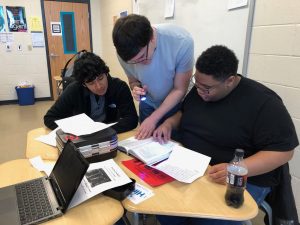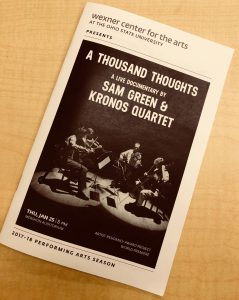One of my greatest pleasures is reading poetry. This hasn’t always been true. I used to hate poetry.
First, I had to get past the Great Lie that in order to appreciate poetry, I had to pick it apart to understand it. I was the student from Billy Collins’s “Introduction to Poetry” who tied a poem to a chair in order to get a confession out of it. I mean, I’m an English teacher. That’s what I was trained to do, right?
As a PAGES teacher, I have had the opportunity to experience various paintings, writings, songs, dances, fabrics, sounds, photos, videos. At first, I tried beating them with Collins’s hose to see what they really meant.
However, also as a PAGES teacher, I was taught to show my students a way in. I had to build a place of trust and then let them play with words and sounds. And to do this, I had to DO what I expected them to do.
I was fortunate to be immersed in my own creative expression. (Confession: I might consider myself expressive but I wouldn’t call myself creative. Or a writer. I used to think I hated it. But PAGES showed me a way in.)
Here are some of my favorite creative writing prompts that inspired me and my students, all gifted to me through PAGES and Dionne Custer Edwards, Kari Gunter-Seymour, and other PAGES resident artists and teachers.
Listing. I might not feel like I can write a poem or a story, but I can write a list. I try to come up with an unusual one like, “Things I Wish I Had Said,” or “Things That Were Said That I Wish I Could Forget,” or “What Triggers Me,” or “Things I Daydream About” (this was a student’s idea), or “Things I Can’t Throw Away,” (thanks, Kari) or “If You Knew Me” and “If You REALLY Knew Me.” Maybe my creative expression IS my list or maybe I take an item from my list and write about that.
Letter writing. This year I’ve had students write letters to their dead dog, Drugs, Martin Luther King Jr., and Depression.
Listing and letter writing. Go from a negative space to a positive space. Make a list of all the times when I have felt less than or unworthy. Then, make a list of all of my positive qualities (and I could use a friend to help). Finally, write a letter to myself going from my negative space to my positive space.
Listing and letter writing #2. Kari Gunter-Seymour once had us write a list of what triggers us. Then, we made a list of people we wish we could have a conversation with. Finally, we chose the fourth person and the second trigger and we wrote a letter to that person about our trigger. I wrote a letter to Jesus about my bad dogs.
Free Association Poem. Choose a word. List words related to that word. Use the words from the list to write phrases and then see how I can combine them.
My list: clock, time, past, future, age, grandma, death, life
She glanced at the clock on the mantle
Her life was running out of time
She can no longer remember her past and her future doesn’t exist
She is the same age as her grandma
When she met death
Soundscapes. Find ambient sounds of cities, streams, thunderstorms, coffee shops. Play one and find myself there. I can describe the sounds and what I see there.
Perspective. To get us thinking about Cindy Sherman’s photography, Dionne Custer Edwards gave us a costume prop (a frilly hat, feather boa, cane, beads). We donned the item and then wrote from the perspective of the owner of that item.
Visual art backstory. In the art gallery, I’ve had students choose a photo or a painting and imagine what happened before, during or after whatever was captured in the piece. For example, here is something I wrote about one of Cindy Sherman’s photographs:
“Serenity”
The dead woman’s eyes gaze into the rising sun.
She contemplates her existence.
She is not angry,
she is not terrified,
she accepts.
There is a serenity in her acceptance.
These are just a handful of ways I have found my way into thinking creatively for myself and some of my students. I am grateful for PAGES showing my South-Western Career Academy students ways to find their words, their voice.
So yes, one of my greatest pleasures is reading poetry. Maybe someday, I’ll be able to say that one of my greatest pleasures is writing poetry.
I’m working on it!
















